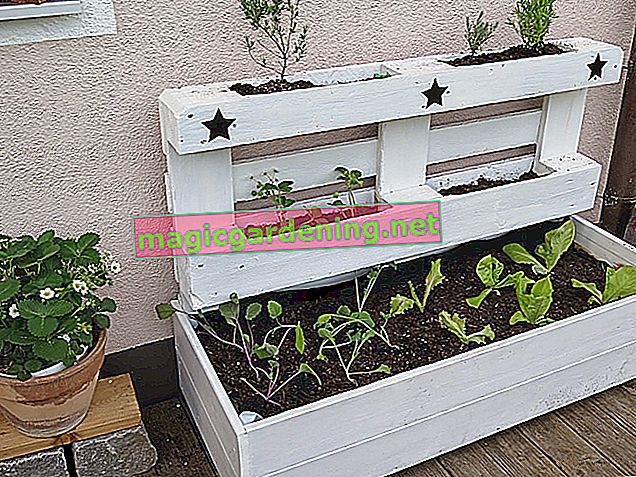
origin
To say it in advance: In this article we are not dealing with the real giant bamboo, the Dendrocalamus giganteus. This actually largest type of bamboo grass is actually irrelevant for the average hobby gardener. The Dendrocalamus giganteus grows to 40 meters high in its tropical, Far Eastern home areas and forms enormous stalks of up to 35 centimeters - so it does not fit into a normal German private garden, both for climatic reasons and for reasons of space. In this country it can only be admired in tropical houses in botanical gardens.
also read
- How big is the giant bamboo?
- How to plant the giant bamboo - tips and tricks
- Is the giant bamboo hardy?
So although in the following there is no real giant bamboo, we will use the name giant bamboo.
What is offered in garden centers under the over-generalized term giant bamboo usually belongs to the genus Phyllostachys. These species are also known as flat-tube bamboo because their stalks are flattened on one side. They are of the greatest importance in garden culture in all of Central Europe. Because the Phyllostachys species also reach considerably large, but still manageable heights, which in private gardens provide effective privacy protection and at the same time a characterful Asian flair. With their clear, graphic appearance, the sweet grasses fit particularly well in front gardens of modern, geometrically linear architecture.
Like most types of bamboo, the giant bamboo comes from the Far East. Its distribution areas extend from Myanmar via China down to Thailand and Indonesia. In general, bamboo has a very high cultural significance there, as it has been used by people for thousands of years as a building material, as a raw material for fabric or small tools and also as food. The larger species in particular develop stalks that are so strong that they have the necessary stability for erecting roof trusses, floors or supporting scaffolding.
According to the more moderate climatic conditions of its distribution areas, the giant bamboo in our latitude can be cultivated in the open without any problems. Due to its tall, dense growth, it is particularly suitable as a privacy screen from neighbors. In addition, it naturally conjures up a characterful Asian flair in the garden. Through his
Origin at a glance:
- Giant bamboo, like most bamboo species, comes from East Asia
- There is a very culture-defining and diversely used plant
- Can be easily cultivated in the local climate
- Especially suitable as a privacy screen
growth
The giant bamboo Phyllostachys is one of the largest species of its genus. With us it can reach a height of up to 10 meters, which is enormous for an average garden. Nevertheless, the real giant bamboo Dendrocalamus giganteus is 4 times as high!
The interesting thing about the sweet grass is that the stalks reach their final height within one season and do not change for years afterwards. Of course, this is only possible if they shoot up incredibly quickly. So you can literally watch them grow!
The stalks form nodes at regular intervals, which ensure the typical segmented bamboo structure and the stability required for the great height. The hollow structure and a wall thickness of around one centimeter also contribute to this. The stalks reach a diameter of about 7 cm.
The giant bamboo grows in clumps and spreads underground through wild rhizomes - an effective and very stable rhizome barrier is therefore essential if you want to prevent uncontrolled, unstoppable forest formation from taking place in the neighboring garden.
The surface of the stalks is surrounded by a smooth layer that protects the grass from weather and other environmental influences.
Growth characteristics in brief:
- Giant bamboo grows up to 10 m high with us
- Culms reach their final height within one season
- Typical segmentation by nodes
- Strong underground rhizome expansion - set up a rhizome barrier!
Continue reading
leaves
Long, sessile leaves grow on the branched stalks
blossoms
The bloom of the giant bamboo is - similar to, for example, agaves - usually a unique spectacle. Because it is usually only developed once in the life of a plant individual and it is not uncommon for it to die. In contrast to Dendrocalamus giganteus, however, this is not a must. A Phyllostachys bamboo can definitely survive one or more flowers and also forms them at shorter intervals, not after 30 or 40 years.
Which location is suitable?
The giant bamboo makes no special demands on its location. Above all, it can cope with almost the entire spectrum of possible soil conditions. For example, it assumes a clay soil as well as a loose, poor sandy soil or a peaty humus soil. Nor does it need a particularly acidic or particularly chalky soil environment - it can cope with both. As far as the lighting conditions are concerned, he prefers a sunny, warm place, but is also satisfied in partial shade.
Of course, what needs to be kept in mind when choosing the location is the likely size and the will of the plant to spread. If necessary, talk to your neighbors about the expected shadows and pay close attention to the incorporation of a stable rhizome barrier. It is best if you hire a specialist to do this.
Site requirements at a glance:
- In terms of soil technology, giant bamboo hardly makes any demands: it can cope equally well with clay, sand or peat soil
- Also the pH value is pretty irrelevant
- Rather sunny and warm
- Take the expected height into account
- Don't forget the rhizome barrier
Pour the giant bamboo
Because of its evergreen foliage, the giant bamboo is quite thirsty. So water it regularly and extensively, but always avoid waterlogging. Watering is also necessary in winter, but of course less because of the lower evaporation. In summer, on the other hand, water only in the morning and evening hours if possible because of the higher evaporation.
It is also important to wash it in thoroughly when planting.
Casting practice in brief:
- Giant bamboo needs a lot of water because of its evergreen foliage
- Water all year round
- Generously in summer and, if possible, mornings and evenings, less in winter
Fertilize giant bamboo properly
The giant bamboo does not necessarily need to be supplied with additional nutrients. As a rule, it is sufficient if you add a good amount of ripe compost or horn shavings to the soil when planting (€ 6.39 on Amazon *). In the following years you can always give him some fresh compost. Alternatively, you can use special bamboo fertilizers or lawn fertilizers, which provide a lot of nitrogen and potassium.
Hardy
The giant bamboo is relatively tolerant of frosty temperatures. It can withstand temperatures down to -15 ° C and can therefore be planted in most parts of the country without any problems. In the first few years after planting, however, it doesn't hurt to protect it a little from the cold. It is best to cover the planting site with a layer of leaves, mulch or straw, which must be removed in spring. The stalks can be wrapped with bast mats, especially in the case of even younger giant bamboo.
Continue reading
Propagate giant bamboo
Due to the clumpy spread of rhizomes, bamboo can be propagated well by division. To do this, cut off part of the grass with the spade in spring. Another, albeit time-consuming, variant is seed cultivation.
Cultivation
If you want to have a giant bamboo in your garden, but want to save yourself the purchase of container goods from the garden center, you can simply put it on yourself. That costs less money, but of course more time to get to the stately giant bamboo hedge. Seeds can be bought in stores. The cultivation can be carried out in the house all year round and does not require any special effort. All you need is a couple of pots of potting soil and a bright, consistently warm place of around 25 ° C.
The seeds of the giant bamboo are light germs. So just sit on the moistened soil and press it lightly. As an alternative to potting soil, coconut fiber is also suitable as a seed base. Before planting, you can increase the germinability of the cereal-like seeds by allowing them to soak in water for 24 hours.
Cover the cultivation container with foil to ensure an evenly warm, humid microclimate. If you have a mini greenhouse (€ 6.96 on Amazon *) available, it is of course even better. Above all, you can then provide the necessary ventilation more comfortably. The first seedlings should show up after about one to three weeks.
Before you plant the giant bamboo outdoors, you should keep it indoors for a while and get used to the harsher conditions outside. He should get “puppy protection” for at least a whole year. If you have sown it early in the year, leave it in a closed area for the winter after next. A transition phase in the cold house is recommended. After that, the plant is well prepared for life in the garden.
To note:
- Sowing is uncomplicated and can be carried out in the house all year round
- Place in pots with potting soil or coconut fiber in a light, 25 ° C warm place
- Light germs - so do not cover with soil
- Germination after 1-3 weeks under foil or in a mini greenhouse
- Keep it in the house for at least another year
- Transitional phase in a cold house, then plant outdoors
Continue reading
sorts
Phyllostachys vivax 'Aureocaulis'
This type of flat tube bamboo enchants with an attractive, green striped structure and reaches a stately height of up to 8 meters.
Phyllostachys bissetii
The bissetii is the most frost-tolerant variety of flat tube bamboo and is therefore suitable for particularly cold parts of the country. Its stalks are deep green and form a dense, hedge-suitable grove.
Phyllostachys nigra
As the name suggests, the peculiarity of this variety lies in its black, violet color, which occurs when exposed to sunlight. When young, the stalks are still light green. The violet-black looks very decorative, especially in contrast.
 Indoor
Indoor  bamboo 6.82 EUR Buy at baldur Bamboo rarities collection 29.42 EUR Buy at baldur
bamboo 6.82 EUR Buy at baldur Bamboo rarities collection 29.42 EUR Buy at baldur







